This is a Nikon FA 35mm SLR camera which was one of the most technologically advanced cameras of it’s day. Upon it’s release in 1983, Nikon advertised it as the “Technocamera” due to it’s many innovative electronic features. Several of the FA’s features are still considered relevant today like it’s CPU controlled matrix metering (called Automatic Multi-Pattern metering), titanium shutter capable of speeds as high as 1/4000 sec, LCD display in the viewfinder, and full Program auto exposure. Many of the features of the FA were not available on Nikon’s professional level camera of the time, the F3. It would be another 5 years when Nikon released the F4 that Nikon would have a more advanced model. By the time the F4’s release however, manual focus cameras had fallen out of favor with the public. As a result, the Nikon FA remains Nikon’s most advanced manual focus camera they have ever made.
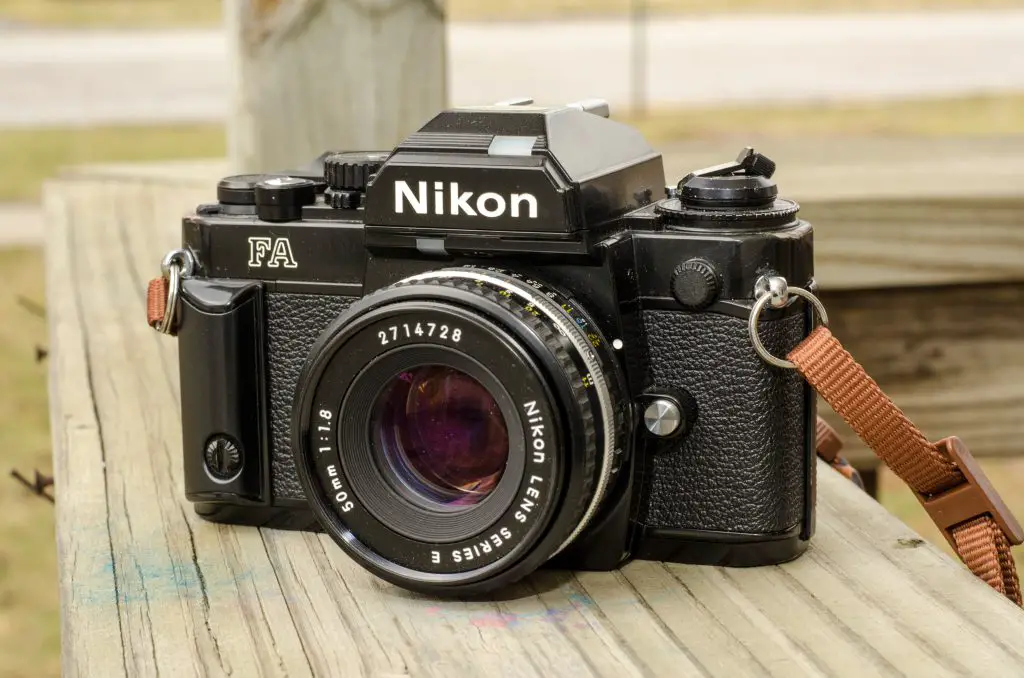 Film Type: 135 (35mm)
Film Type: 135 (35mm)
Lenses: Nikkor 50mm f/1.8 + many others
Lens Mount: Nikon F Bayonet
Focus: Variable
Viewfinder: Fixed SLR Pentaprism with full information LCD display
Shutter: Focal Plane Vertically Traveling Titanium Blade
Speeds: B, 1 – 1/4000 seconds
Exposure Meter: CPU Controlled Multi Pattern TTL Matrix Metering
Battery: 2 x S76 Silver-Oxide or Alkaline Battery
Flash Mount: Flash TTL Hot Shoe with 1/250 second flash sync and PC sync port
Weight: 625 grams (body only)
Manual: http://www.cameramanuals.org/nikon_pdf/nikon_fa.pdf
How these ratings work |
The Nikon FA is not the first, second, fifth, or even tenth Nikon SLR listed at the top of most people’s favorite Nikon SLRs but perhaps it should be. Offering a perfect balance of fully manual control along with state of the art modern conveniences like full Program Auto Exposure, a titanium blade shutter with a top speed of 1/4000, and automatic multi-pattern metering, the Nikon FA is an extreme value on the collector’s market today for it’s complex feature set, and compact and ergonomic body. | ||||||
| Images | Handling | Features | Viewfinder | Feel & Beauty | History | Age | |
| 2 | 2 | 2 | 1 | 2 | 1 | 0% | |
| Bonus | +1 for the complete package, my favorite Nikon | ||||||
| Final Score | 11.0 | ||||||
History
By the early 1980s, Nikon’s (technically they were still known as Nippon Kōgaku until 1988 when the company officially became known as the Nikon Corporation) reputation as a maker of extremely well built cameras was well known throughout the world. Their professional line of cameras known as the F-series was the preferred choice of photographers everywhere. Even their “consumer” lines of cameras were built with a quality standard that was second to none. Nikon simply didn’t know how to make a cheap camera.
Another thing that Nikon was known for was taking their time to incorporate advanced new features into their cameras. They weren’t usually in a rush to be the first to introduce new features to the marketplace. They were not the first with features like automatic exposure, program mode, auto focus, or TTL metering. Even the original Nikon F from 1959 was released several years after other Japanese camera makers had debuted their new SLR models.
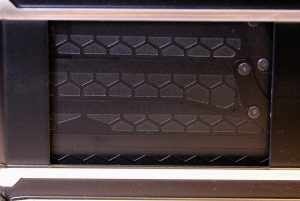
So although Nikon would typically take their time to release a new feature, when they did, they would usually hit the nail right on the head and do it right the first time. This is the story of the Nikon FA, Nikon’s first camera with full Program exposure mode and a CPU controlled matrix metering exposure system. It shared the same honeycomb pattern titanium shutter from the Nikon FM2/FE2, and a mostly metal body with composite external coverings.
The FA was introduced at a very tumultuous time in the photography industry. Auto focus was already starting to become common with point and shoot cameras, and it was on the verge of penetrating the SLR market. Minolta would release the world’s first auto focus SLR, the Maxxum 7000 less than 2 years after the FA’s release, and Canon’s EOS system was not far behind that. Consumers were flocking to cheaper and easier to use cameras with more automatic control. Plastic was becoming the preferred material in the construction of cameras and lenses. Even the pro market was starting to notice conveniences like motorized film advance and auto focus. So when the FA was released, it was one of a very small number of very well built, high spec, all manual cameras. Despite this, it remained in production until early 1988, and continued to be sold from new dealer stock for another year and a half.
In May 1984, Popular Photography performed a comprehensive test on the Nikon FA and posted their findings in this massive 10 page article.
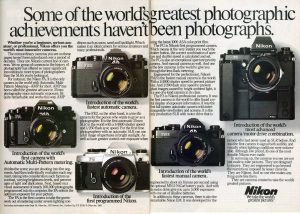
Nikon placed the FA in their model lineup above the excellent, but rather basic FE2, and below the pro-level F3 (and its variants). According to the Dec 1983 issue of Popular Science, the list price for the FA body only was “about” $650. Back then, it was very common for retailers to sell products at 20% – 25% below list price putting it’s actual retail price somewhere around $475. Still, when adjusted for inflation, $475 in 1983 is $1132 in 2015 which is quite a lot of money to spend for a camera.
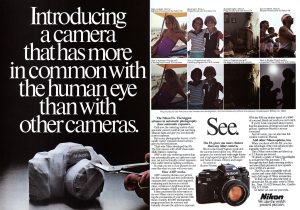
Like most Nikons, it is very difficult to know the exact number of Nikon FAs made, but I do know that they started with serial number 5000001. The example in my collection is 53509xx which tells me at least 351,000 were made. I don’t know that it sold particularly well, but it wasn’t a failure either. The fact that it was made for about 6 years says that it had to have been at least somewhat popular. I have no evidence to prove this, but my guess is this camera probably sold somewhere in the neighborhood of half a million units during it’s run.
Today, the Nikon FA is somewhat of a forgotten model. Although most photographers who were active in the 1980s remember it well, most everyone today tends to remember the pro-level F3, or the less feature-packed FE2 and FM2. As a result, you can often find FAs on the used market for quite a bit cheaper than F3s despite it being a technologically superior model. In vintage camera discussions, you simply don’t hear as much talk about the FA as other manual focus Nikons.
My Thoughts
I’ve mentioned it in other posts, but I’ll say again that I am a self professed Nikon fanboy. I prefer their DSLRs over the competition and find their lenses to be generally superior pretty much across the board. Sure, Canon and other vendors have good lenses too, but sometimes they can be hit or miss. Nikon, in my opinion, is consistently excellent all the time.
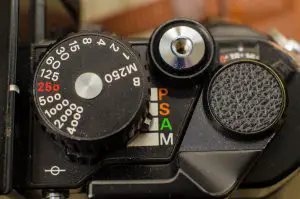
So, of course in the early years of my re-discovery of film cameras, I naturally started with Nikon. My first model was a pretty beat up Nikon EL2. I loved that camera, but it was in physically rough shape and had issues with the film pressure plate. It would not put even pressure on the film plane and I would get randomly out of focus shots.
I have since sold that EL2 and bought many other Nikons. I’ve had a couple different FTns, a Nikomat EL, two different FMs, an FE, an N80, and this FA. I can say with confidence that this FA is my favorite Nikon. In addition to all of the techno-doodads that this camera has, it’s still from the classic era of solidly built metal cameras. It has a removable finger grip on the right side of the camera which foreshadowed the much larger grips that would come on later models. Sadly, this grip is often missing on used FAs, so if you are in the market for one, be sure to look for one that has it still attached. It’s a worthwhile feature of the camera, and unless you plan on mounting a motor winder, the camera looks goofy with the grip removed.
The camera is neither too big or too small, neither too heavy or too light. All of the controls are in logical locations, and despite the long list of features, the camera still has a clean and logical design. I once handled a Canon A1 and I found the top plate of that camera to be extremely disorganized and cluttered. Even the Minolta XD11, which is another well featured camera with Program mode, does not feel as natural in your hands as the FA.
If there is one nitpick I have with this camera is that the early adoption of a LCD display in the viewfinder is not back lit, making it extremely difficult to see in anything but bright light. Canon used bright red LEDs for their digital display in the A1, and I wish that Nikon had done a little better job here.
I mention in the history section above that the FA is somewhat of a forgotten model, and while some may disagree with that statement, I stand behind it because in the first year or so of collecting vintage cameras, I didn’t even know it existed. I learned of the FG before this model. When I heard of an FA, I figured it was just some basic model from the 80s. Boy was I wrong. When I first started searching for one eBay, the prices were either above my budget, or the cameras were in poor condition.
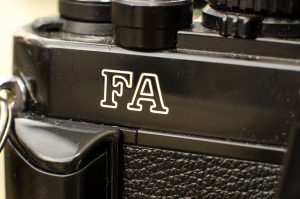
Then one day I stumbled upon a lot of two FAs, both from KEH in Atlanta, GA. They were selling them in “As-is” condition due to missing parts. As it turns out, both cameras had the film rewind knobs removed, yet otherwise looked to be in excellent condition. I won both cameras for $35 and when they arrived, I was pleased with the overall condition. I tested both with a fresh battery and both worked fine. I have no idea why anyone would just remove the film rewind knobs of two otherwise perfectly working FAs. I had a non-working FE that I had been using as a parts camera, so I removed the film rewind knob from that one and tried it on the FA. Its not a perfect match, but it does work. Maybe one day I’ll come across the correct knob from an FA, but until I do, the FE’s knob will work fine.
Both were in need of light seal replacement, so I replaced them on both cameras and gave them each a good wipe down. I listed the other one on eBay explaining the condition of the camera and stating it only needed a new knob. I sold that one for exactly $35! It helped that I could guarantee that the camera worked, plus it had all new light seals, so whoever bought it, got a pretty good deal. I, on the other hand, got the best deal, because now my total net cost for the FA I kept was $0!
My Results
I took my FA with me to see a 2 day music festival in Midtown, Atlanta, GA in Sept 2015. I foolishly loaded a roll of 200 speed film into the camera knowing that I would be shooting indoors at a concert, and many of the shots came out blurry due to long shutter speeds, but thankfully for the second roll, I had a roll of Fuji 800. Of course the 800 speed film fared much better in the dark interiors of the concert venue.
I shot every single one of these with a Nikon Series E 50mm f/1.8 lens since its the only manual focus Ai-S lens in my collection. You need an Ai-S capable lens in order to use full Program mode on the FA. With an Ai-only lens, you can still use the camera in Aperture Priority mode, but neither Shutter Priority or Program mode will work. Non-Ai lenses will not attach to the FA.
The thing about Nikon is that their bodies and lenses deliver such consistently high quality shots, that reviewing each exposure is pretty boring. They’re all going to turn out great, assuming the camera is functioning correctly, and you didn’t screw something up. This is why I shot all of these (except the bridge photo) in full Program mode. I figured I might as well test the camera’s ability to handle difficult light situations.
In summary, yeah, it worked great! The Nikon FA was an excellent camera with state of the art features when it first debuted over 30 years ago, and it still is today. Its a testament to the quality and reliability of Nikon that this thing still does everything it was intended to, without any hiccups over a quarter of a century later.
Some people may not have any interest in shooting a film camera in Program mode, but I do. While full manual modes have their benefits, if I wanted the pleasure of shooting film indoors in difficult lighting conditions, you simply cannot beat it. Sure, I could have brought a separate light meter, but sometimes you want a camera to just shoot and not get in the way and thats exactly what the FA is good for. I’ll always love my other Nikon bodies, but the ergonomics, weight, and size of this camera, combined with its excellent ability to handle almost any lighting condition means it will most likely be my go-to camera of choice when I want to shoot with an SLR.
Related Posts You Might Enjoy
External Links
http://mir.com.my/rb/photography/hardwares/classics/nikonfa/
http://www.dantestella.com/technical/nikonslr/nikonslr.html
http://camera-wiki.org/wiki/Nikon_FA
https://en.wikipedia.org/wiki/Nikon_FA
http://camerapedia.wikia.com/wiki/Nikon_FA
http://www.kenrockwell.com/nikon/fa.htm
http://www.nicovandijk.net/fmfefa.htm
https://camerapassion.wordpress.com/2013/05/07/nikon-fa/
http://www.luistriguez.es/fotos/cameras/nikon_fa/index_nikon_fa.htm
http://www.hugorodriguez.com/articulos/nikonfa.htm (Spanish – Use Google translate)


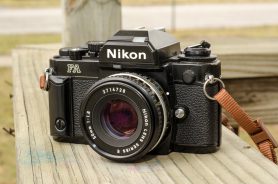
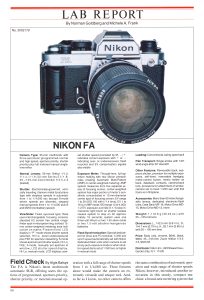
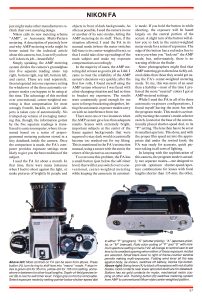
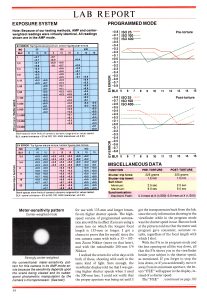
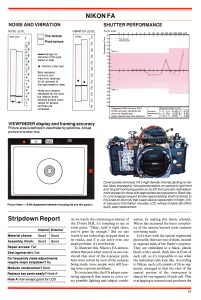
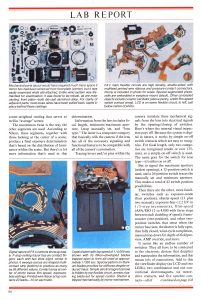
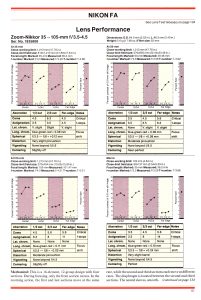
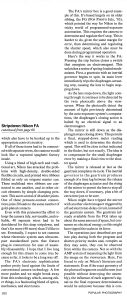

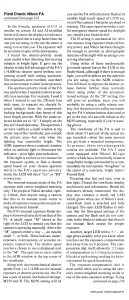
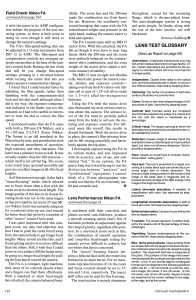








You foolishly (your words) used 200iso indoors.. uh, not foolish if you have a tripod, and a flash. Don’t you come prepared? I have a pocket metal tripod that fits in my pocket, and a speed flash is like $20 on feebay. I have taken many stablized shots indoors with even 64iso. You can use edges, wedges, coats, stacks of books, glasses.. to great effect if you want stable long shutter shots. be creative. that’s the essence of an honest photographer. Watch the environment, or subjects. This goes hand in hand to shutter speeds. A concert is friendly to some blurring and smearing with a double exposure with flash for example.
Thanks for the tips, Otis. You make good points about the ways in which you can shoot slower speed indoors. I should clarify that I am not, nor have I ever claimed to be a good photographer. I’d hesitate to call myself even an average one. I’m just a guy who likes old cameras and gets a thrill out of using them. Sometimes I make a pretty good photo, sometimes not. I’m still learning though and hope to one day get better. 🙂
Mike,
I too have fun shooting with my film cameras. Many years ago, the ex brother in law bought a “Lacon” fixed lens camera in Japan for the ex and I. It sort of worked, and I think I got two really worthwhile photos out of 40 to 50 rolls of ISO 200 film. Turned off my photoraphy desires.
A good friend had decided to switch to point and shoot cameras, and offered me his Nikon FE with a few off brand lenses, and a flash. I decided to jump on it. I got so I could get a fairly good, for me, outdoor, picture out of 2 to 3 shots. Indoors was terrible, with no filters and varied light sources really helped me shoot up a lot of film with no success.
Still, I was hooked on Nikon, and bought a couple of Nikon Nikkor lenses to use, which seemed to help, but while I know a lot of information about cameras and lenses, and would try to record data for most shots, my skills were not improving much.
An FE2 was offered to me, and while I have been impressed with it’s high shutter speed, it seems to take very few reasonable photos (I know it’s the nut behind the camera, that is the problem). A few more Nikon Nikkor lenses were gained.
A deal was offered to me by a pro photographer that I knew. He had a deal to buy 6 Nikon F5’s, and get almost 25% off if he bought all of them. He was wary, but confirmed that the cameras were not stolen, and it was a legitimate deal. Then I had what is arguably the best 35mm film camera ever built. Some of my pictures were ones that I consider good, a pro would probably throw them away. I just lost all desire to take pictures for a couple of years, maybe it was part of me filing for a divorce.
Moved in with some friends, and one of them had a friend from Japan, visit, who had lived with his family as an exchange student. I met him and it turns out he was very high up in management at Nikon. He smiled when I showed him.my F5, and said nobody, even Nikon, can make a better 35mm camera!
D200 + 17-55mm f 2.8 and it got stolen with some other f2.8 lenses. Down in the photography dumps again. Decided to buy a friend’s F3HP, with a couple of f/2.8 lenses to replace some that had been stolen from me.
Found a used D200 (wrong s/n, not my stolen one) and an 18-200mm lenses. Started to get excited again, bought a book to work more closely with the D200, when I received the book it was for a D300, now, I had to get a D300, and found one, it too besides the D200 was used, but still excellent.
The film bug bit me, when another friend offered to give me an excellent FA, which I kind of knew about it being a good camera. Read up on it’s capabilities, and WOW, I should have bought one instead of the FE2, way back. I am finally learning how to shoot photos, I said learning, still not a very good photographer, but learning.
I take the D300, and the FA with me when I go to shoot photos, to see what my film photos should look like right away. I am beginning to realize that the wait for the developed film, kept my interest in photography way down. Digital, especially with the ability to view the photo and details right away keeps me more focused.
According to Rockwell’s FA review (which you cite), both AI and AI-S lenses are fully functional with the FA. The only difference is that the FS won’t kick into High Speed Program mode with an AI lens that’s longer than 135mm, it will remain in regular program mode. You need an AI-S lens to kick it into high speed mode.
Based on many years of using this camera, I assure you that program, A, and S modes all work with AI lenses (not converted AI lenses) as well as AIS lenses and both use the matrix metering. Some ais vs. ai lenses will trigger a different metering mode (for example, with long lenses) and those trigger generally faster shutter speeds which can be helpful with handheld long lenses.
Hi Mike, great review. Are you still using the FA these days? It would be nice to hear some testaments to know its more reliable that it gets credit for!
Sadly I have not. The constant cycle of reviewing cameras limits my ability to go back and revisit some older ones, but the FA is worthy of an extra roll. Later this summer, I’ll be sure to take it out again and give a quick 2022 update…assuming it’s still working! 🙂